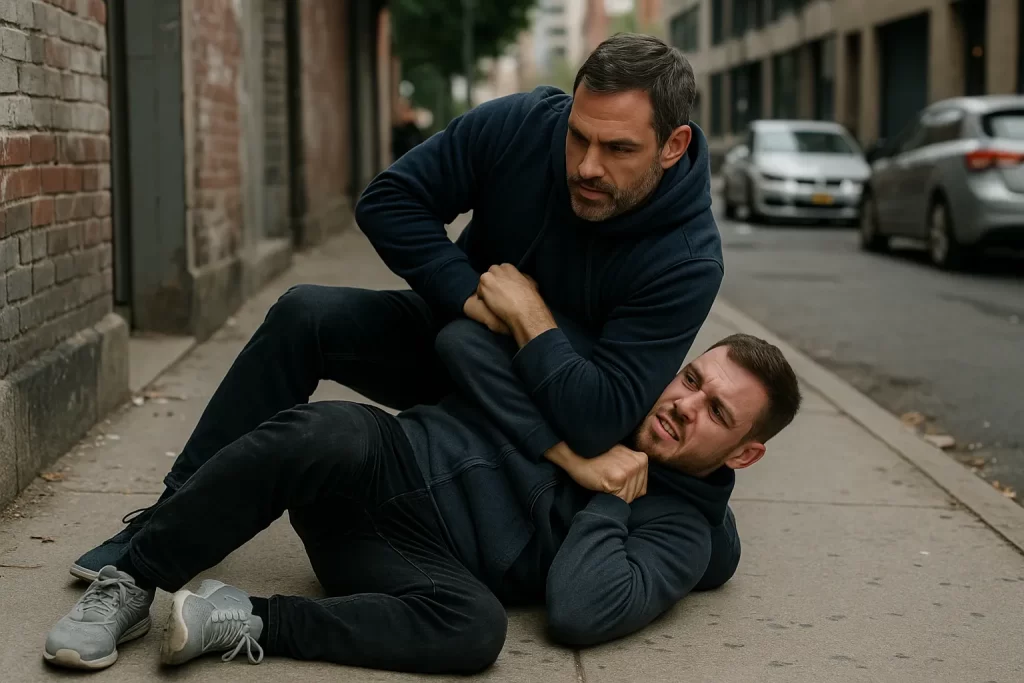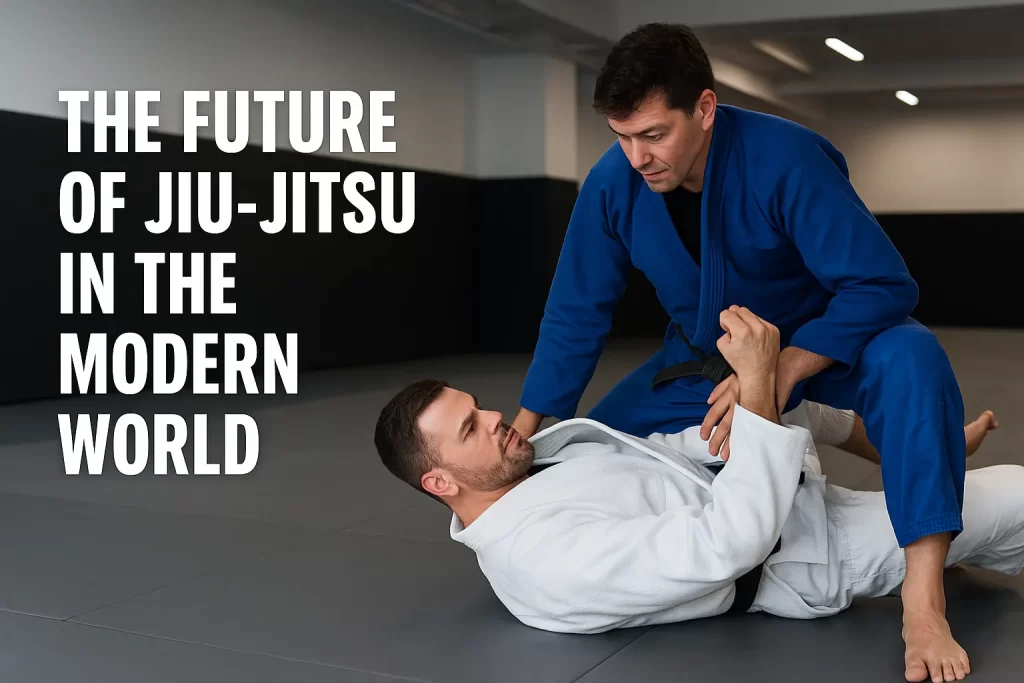Understanding the Role of Jiu-Jitsu in a Rapidly Changing World
Jiu-Jitsu has come a long way from its feudal roots in Japan and its later evolution into the Brazilian combat sport we recognize today. In 2025, the art stands at a pivotal crossroads, blending ancient principles with the demands of a high-tech, fast-paced society. Whether you’re a beginner looking to choose your first martial art, or a mid-level practitioner reflecting on your journey, understanding where Jiu-Jitsu is headed is crucial—not only for personal growth but for aligning your training with the world around you.
The Modern Context: Why Jiu-Jitsu Still Matters
Mental and Physical Fitness for a Tech-Driven Society
Today’s world is dominated by desk jobs, screens, and increasingly sedentary lifestyles. Jiu-Jitsu offers a compelling antidote:
- Physical Benefits: Flexibility, core strength, cardiovascular endurance, and functional movement.
- Mental Benefits: Stress relief, emotional regulation, problem-solving under pressure.
Studies have shown that martial arts practitioners report significantly higher well-being than non-practitioners. A 2023 study by the International Journal of Sports Science found that BJJ practitioners had 30% lower reported stress levels and improved cognitive flexibility after 6 months of consistent training.
“Jiu-Jitsu isn’t just a sport—it’s a full-spectrum lifestyle discipline designed for the modern human.” — Prof. Felipe Costa, BJJ World Champion
Urban Safety and Practical Self-Defense
Unlike striking styles like boxing or Muay Thai, which require space and deliver maximum damage, Jiu-Jitsu thrives in close quarters—making it especially relevant for urban environments where self-defense often involves grappling.
Jiu-Jitsu vs Other Martial Arts for Urban Self-Defense
| Feature | Jiu-Jitsu (BJJ) | Muay Thai | Karate | Krav Maga |
|---|---|---|---|---|
| Close-contact efficiency | ★★★★★ | ★★ | ★★★ | ★★★★★ |
| Control without damage | ★★★★★ | ★ | ★★ | ★★★ |
| Ground game | ★★★★★ | ★ | ★ | ★★ |
| Legality of techniques | ★★★★★ | ★★ | ★★★ | ★★ |
| Suitability for civilians | ★★★★★ | ★★★ | ★★★ | ★★★ |
Jiu-Jitsu’s Evolution: Trends and Transformations
A Shift Toward No-Gi and Hybrid Training
Traditional BJJ emphasized the use of the gi (kimono), focusing on grips and control that mimic traditional judo. However, No-Gi Jiu-Jitsu is rapidly taking over:
- More applicable to real-life situations (no one wears a gi on the street).
- Faster-paced and more athletic, attracting younger generations.
- Often favored in MMA and self-defense contexts.
Current Trend (2024–2025):
📊 60% of BJJ tournaments in North America are now No-Gi events.
📈 Instagram hashtags for “NoGiBJJ” are growing 2x faster than “GiBJJ”.
Expect more schools to offer hybrid programs with wrestling, judo, and even sambo elements over the next 5 years.
Technological Integration and Smart Training
Modern Jiu-Jitsu is becoming smarter. From wearable motion sensors to AI-driven technique analysis, schools and athletes now use:
- 3D video breakdowns of rolling sessions.
- Biomechanical analysis to optimize leverage and pressure.
- Virtual sparring and remote coaching apps.
Some leading gyms, like Atos HQ and Renzo Gracie Online Academy, are incorporating wearable tech and custom-built learning platforms to allow students to review and refine techniques using slow-motion analytics.
Growth Among Non-Traditional Demographics
Jiu-Jitsu has historically been male-dominated, but that’s changing rapidly:
- Female practitioners now represent nearly 28% of new BJJ memberships globally (2024 data from IBJJF).
- Older demographics (40+) are joining for longevity, posture correction, and neuroplasticity benefits.
- Neurodiverse individuals and those with anxiety disorders find BJJ’s structured and tactile environment therapeutic.
🧠 A 2022 study from Harvard Medical School linked regular Jiu-Jitsu practice with a 22% improvement in executive function for adults over 50.
Predictions: What the Next 10 Years Hold
Prediction #1: Integration into Public Health and Education
Don’t be surprised if your child’s high school PE program includes Jiu-Jitsu. With its emphasis on discipline, resilience, and non-violent control, BJJ is ideal for:
- Anti-bullying programs
- Confidence-building in youth
- Violence prevention for teens and young adults
By 2035, we may see Jiu-Jitsu on the curriculum of public schools in countries like Brazil, the US, and Japan.
Prediction #2: Global Cultural Influence and Olympic Inclusion
While BJJ was added to the 2022 Asian Indoor and Martial Arts Games, Olympic inclusion still eludes it. However, with recent lobbying by the IBJJF and support from Judo federations, there is momentum:
🥇 “If momentum continues, we could see Jiu-Jitsu in the Olympics by 2036, likely in a modified, sport-specific No-Gi format.” — Andre Pederneiras, Nova União
As global visibility increases, expect more hybrid competitions, reality series (like Who’s Next by FloGrappling), and even virtual leagues.
Practical Applications: How Jiu-Jitsu Adapts to Your Life
Scenario 1: The Corporate Professional
- Problem: Sedentary job, mental fatigue, and stress.
- Solution: Jiu-Jitsu provides both a physical outlet and mental reset.
- Impact: Boost in productivity, posture improvement, and stress reduction.
Scenario 2: The Single Mother in an Urban Neighborhood
- Problem: Safety concerns and lack of time.
- Solution: Two classes per week focused on defensive Jiu-Jitsu.
- Impact: Confidence in managing physical threats, social bonding with peers, safer walking routes.
Scenario 3: The Teen with Social Anxiety
- Problem: Difficulty with eye contact, assertiveness, and stress management.
- Solution: Structured drilling and live sparring in a safe, rule-based environment.
- Impact: Better self-expression, reduced panic response, and increased body awareness.
Why Choose Jiu-Jitsu Now?
If you’re on the fence about starting martial arts, here’s why Jiu-Jitsu may be the most future-proof choice:
- ✅ Low injury rate compared to striking arts when practiced safely.
- ✅ Effective across all body types, ages, and genders.
- ✅ Globally available with strong online resources.
- ✅ High adaptability for law enforcement, athletes, or hobbyists.
Pro Tip: You don’t need to compete to benefit. Many modern academies offer beginner-only classes, adaptive curriculums, and “flow rolling” formats that reduce injury risk while maximizing learning.
Navigating Threats to Jiu-Jitsu’s Future
In the first part of this series, we focused on how Jiu-Jitsu is adapting and thriving in the modern world. But like any living tradition, it faces its share of challenges. From commercialization to digital distractions, this second part digs into the realistic threats to Jiu-Jitsu’s survival—and how the community might respond to them.

Belt Inflation and the Credibility Crisis
One of the most hotly debated issues in modern Jiu-Jitsu is belt inflation—the accelerated promotion of students who may not have earned their rank through rigorous testing or competition. As Jiu-Jitsu expands commercially, some schools prioritize customer retention over skill development.
Independent Commentary:
“The minute belts become a business transaction rather than a reflection of skill and dedication, we lose the art’s integrity. People want promotions like they want Amazon Prime delivery—fast, easy, and guaranteed.”
— Author’s Comment
Supporting Fact:
- A 2022 BJJ Heroes survey of over 2,000 practitioners showed that 63% believed belt promotions had become too lenient in their local academies.
- IBJJF has now started publishing more detailed promotion guidelines, but enforcement is voluntary.
Adaptive Response:
- Create third-party certification bodies that assess belts based on sparring footage, seminar participation, and verified hours on the mat.
- Implement peer-review systems where promotions are publicly discussed by multiple black belts in the local community.
Commercialization vs. Tradition
With the explosion of YouTube, TikTok tutorials, and pay-to-roll gyms, traditional Jiu-Jitsu values like lineage, discipline, and dojo etiquette are under threat.
Independent Commentary:
“You can learn a sweep from Instagram in 30 seconds, but you won’t learn humility, perseverance, or what it means to tap with honor. That takes time—and a teacher.”
— Author’s Comment
Supporting Fact:
- Over 45% of new practitioners in 2024 said they started Jiu-Jitsu via online content, according to a Grappling Research Collective report.
- While democratization is good, it often skips foundational philosophies of the art.
Adaptive Response:
- Schools can blend online with in-person learning—structured digital modules backed by dojo-based ethics and feedback.
- Establish code-of-conduct certifications for instructors and academies that meet philosophical and pedagogical standards.
Injuries and Longevity
A growing concern, especially for practitioners over 35, is injury risk. With intense sparring, small joint locks, and live resistance, long-term physical toll is real.
Independent Commentary:
“We talk about Jiu-Jitsu for life, but how many of us actually make it past blue belt with our knees and shoulders intact?”
— Author’s Comment
Supporting Fact:
- A 2021 study in the Orthopaedic Journal of Sports Medicine found that BJJ has an injury rate of 36.1 per 1,000 athlete exposures, higher than recreational basketball but lower than MMA or judo.
- The most common injuries: shoulder (AC joint sprains), knee (meniscus tears), fingers.
Adaptive Response:
- Encourage “longevity paths” within schools—programs tailored for 40+, using positional sparring, flow rolling, and injury prevention drills.
- Cross-training with yoga, mobility, and breathwork is becoming standard in progressive academies.
Everyday Relevance in the Digital Era
Physical Literacy in a Screen-Centric World
Most people today have poor spatial awareness, poor posture, and limited control over their body mechanics. Jiu-Jitsu, with its emphasis on leverage, angles, balance, and timing, trains body intelligence like few other arts.
Real-Life Applications:
- Better falling mechanics reduces injury in elderly populations.
- Enhanced grip strength from regular rolling correlates with lower mortality risk according to multiple health studies (Harvard, 2023).
- Improved hip mobility and spinal stability, especially valuable for office workers.
“I haven’t thrown out my back in two years since starting Jiu-Jitsu. My chiropractor is mad at me, but I’m ecstatic.”
— Beginner student, 41, from Melbourne
Emotional Regulation and Psychological Benefits
One of Jiu-Jitsu’s underrated assets is emotional maturity through repeated adversity.
| Situation | Jiu-Jitsu Benefit |
|---|---|
| Panic during stress | Controlled breathing and spatial awareness from bad positions |
| Conflict at work | Training teaches when to hold back or act decisively |
| Social discomfort | Constant exposure to pressure builds resilience and calm presence |
Social Belonging in an Isolated World
Especially post-COVID, many people feel disconnected. Gyms and dojos are forming micro-communities with strong social bonds, mentorship, and purpose.
Supporting Fact:
- BJJ schools report 81% higher student retention when they actively foster community events (open mats, BBQs, seminars), per Martial Business Network 2023.
Will Jiu-Jitsu Survive the Next 50 Years?
Three Possible Futures
| Scenario | Characteristics | Likelihood | Outcome |
|---|---|---|---|
| Tech-Dominant Hybridization | AI-based coaching, VR sparring, online belt testing | High | Skill democratization, mixed quality |
| Traditionalist Reformation | Return to lineage, formal instruction, mentorship | Moderate | Smaller but purer BJJ communities |
| Commercial Explosion | Belt factories, fitness-only focus, watered-down curricula | Very High | More members, less depth |
“It’s up to us. Styles don’t survive on luck—they survive when people protect the roots while pruning the branches.”
— Author’s Comment
Factors That Will Help BJJ Endure
- Institutionalization: With IBJJF, ADCC, and even local federations organizing and archiving the sport’s structure.
- Cultural Flexibility: Jiu-Jitsu has shown it can absorb influences—wrestling, sambo, judo—without losing its identity.
- Community Role: Unlike solo fitness routines, BJJ is built on shared struggle, a key to human resilience and belonging.
Final Thoughts and Summary
Despite real threats—commercial dilution, injury risks, and philosophical erosion—Jiu-Jitsu stands among the most resilient and adaptable martial arts in today’s world. Its hybrid identity, blending old and new, gives it a unique advantage.
Key Takeaways:
- 🛡️ Threats include belt inflation, commercialization, and injury concerns—but each has emerging solutions.
- 🧠 In daily life, BJJ boosts emotional regulation, cognitive function, and social connection.
- 🔮 Futures may vary, but Jiu-Jitsu’s flexible DNA makes survival very likely.
Final Supporting Fact:
- The number of registered BJJ gyms worldwide increased from 5,300 in 2015 to over 19,000 in 2024 (Martial Arts World Census), indicating not just growth—but global integration.
“If you want a martial art that grows with you, adapts to your body, improves your mind, and builds your tribe—Jiu-Jitsu is one of the few that can truly go the distance.”


